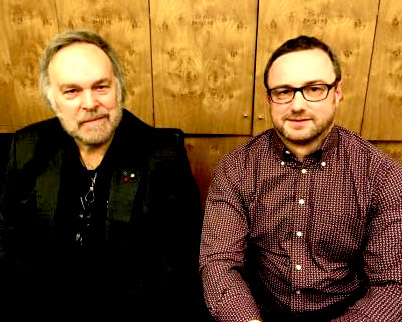by Wine Owners
Posted on 2018-04-13
Slightly weary after several busy days of tasting and driving, we were very happy to start today with a blissful treat; Jacques Thienpont hosting us to taste his 2017 Le Pin. Well-tailored and welcoming, Jacques greeted us with his son Georges, and took time to explain a little of the history behind the two wines we were about to taste: L'If and Le Pin. Both wines were stunning, and L'If - one of the newer additions to the Thienpont collection - shows a clear family resemblance to its legendary big brother. (It's upwards price trajectory does, too). What stood out most in both wines (beyond elegant fruit aromas and a cool-silk mouthfeel) were the feather light, super-ripe tannins. When we asked Jacques how he achieved these, he modestly gave all credit to First floor, saying “Fiona (Jacques' wife Fiona Morrison MW) can't believe how little I do to the wine”. Whatever the case, we have seen tannins like these at only one other winery (Cheval Blanc) in all of our tastings this week. ‘Extremely svelte, no hint of excess', say Nick's 2017 Le Pin tasting notes.
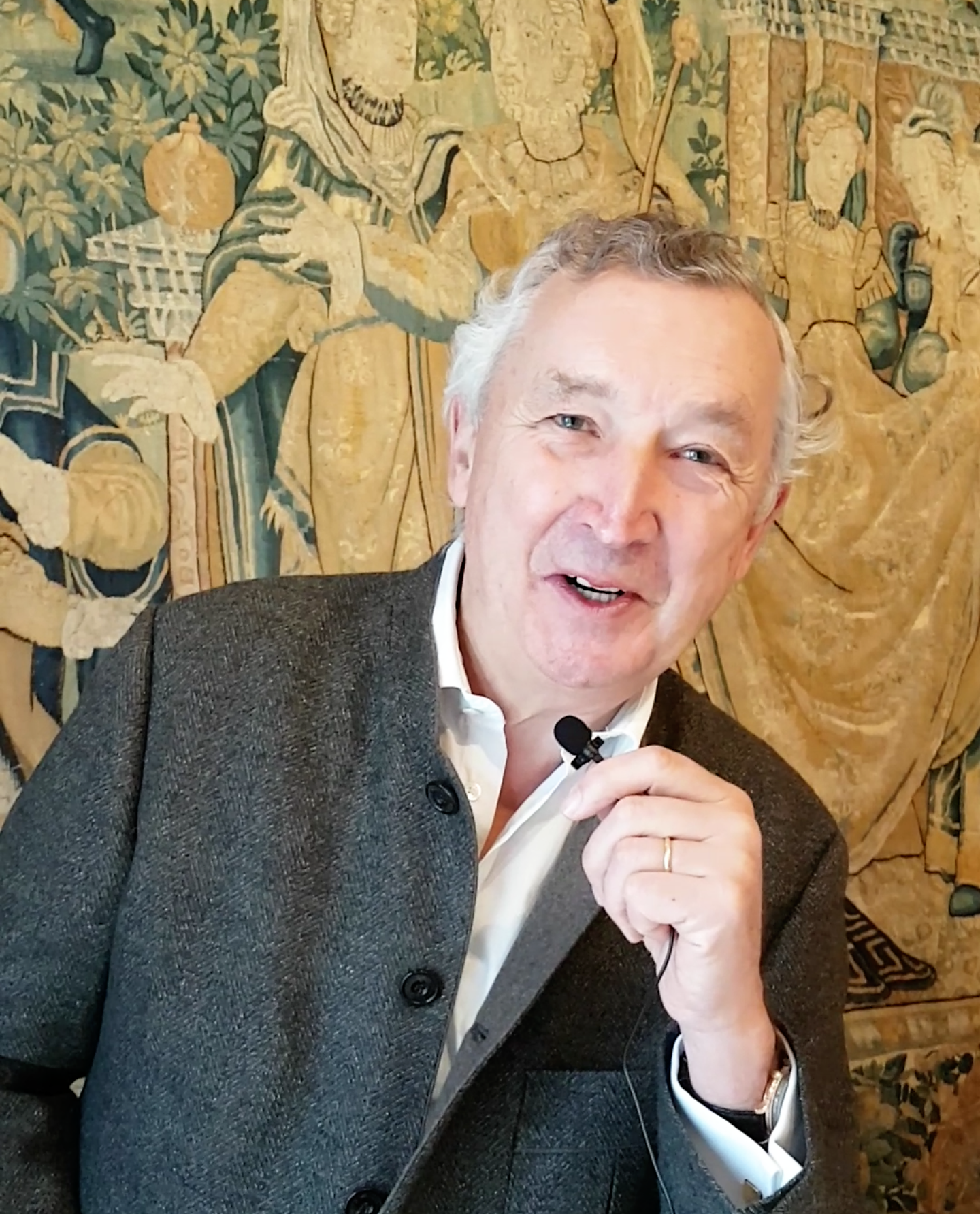
©Jonathan Reeve / Wine Owners
The Right Wine for the Job
The Le Pin tasting highlighted a really basic wine investment tip - one which may easily be overlooked. In the excitement of buying a super-expensive wine like this, an investor may well neglect to factor how many years the wine will actually last. Expensive wine is not necessarily long-lived wine. The world's most expensive wines cost so much because they're excellent and sought-after, not because they take forever to mature. Jacques estimates that the Le Pin 2017 is a wine to drink within ten to fifteen years. That's great if you can get hold of it en primeur and turn it around within a few years, but that really isn't particularly long in investment terms. At the opposite end of the spectrum are two wines of similar stature: Chateau Haut-Brion and Chateau Latour. These two are completely different in style - both from Le Pin and from one another. They are chalk and cheese stylistically, but they are clearly similar in how long-lived they are. The longer the maturation period, the more time there is for speculation and anticipation, and the more time you have to find that well-heeled and motivated buyer.

©Jonathan Reeve / Wine Owners
En Primeur Alive and Kicking
From up-close here in Bordeaux, En Primeur as a buying mechanism (with all its associated practices and processes) seems alive and well. The tasting rooms here are packed and buzzing, all the traditional conversations are happening (again), and tannin-battered tongues are wagging as always. Hopefully this energy will be complemented by sensible release prices in a few weeks' time, and by a decent level of commitment from consumers. And investors...
Watch this space in coming weeks for our thoughts on hot buys, once the producers begin to announce their prices.
by Wine Owners
Posted on 2018-04-11
Reflecting on day two, with the heady aromas of Pavie and co still flickering around our mouths, and a hard day's tasting behind us, we searched for patterns and rules. But, on reflection, there really is no rule that we can suggest.
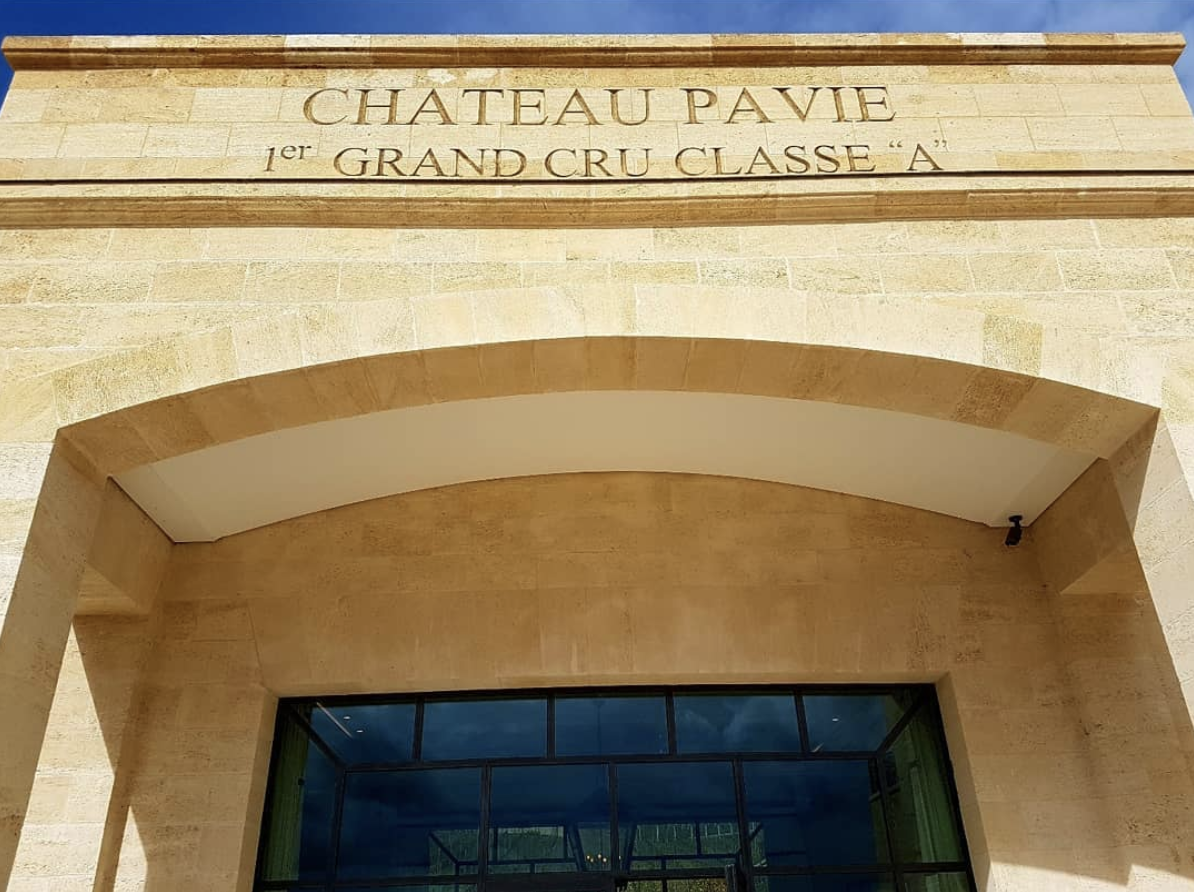
©Jonathan Reeve / Wine Owners
An Unexpected Guest
Cabernet Sauvignon made an larger-than-usual appearance in several top wines we tried today, most noticeably Vieux Chateau Certan and Cheval Blanc. Typically, VCC contains just 1% Cabernet Sauvignon, but in 2017 that was increased to 5%. Although there was no overt Cabernet Sauvignon aroma profile in the wine, its freshness and focus almost certainly added to the completeness of the mouthfeel. Cheval Blanc is a quite different story; 2017 is the first vintage in many years that the wine will contain Cabernet Sauvignon.
©Jonathan Reeve / Wine Owners
Shining Examples of Franc
Cabernet Franc is absolutely not in the dog house in 2017, despite the general impression that it had a tough vintage. Three stand-out wines from today's line-up contained substantial levels of Cabernet Franc; Chateau Troplong- Mondot, Chateau Canon and Cheval Blanc's Petit Cheval. The former pair included around 25% Cab Franc, and Le Petit Cheval put on a blinding performance with a relatively massive 48%. So, while the variety may have had a very tough vintage in some parts of the right bank, it is showing admirably in others.
Frost Patterns
There is a lot of emphasis this week on The Frost (27th and 28th April 2017), and rightly so; it was absolutely devastating from some producers, and has had clear repercussions in their 2017 wines. But not all vineyards were affected, and some seem to have escaped entirely unscathed. Chateau Canon, for example, was almost completely untouched by frost. The wines are suitably excellent - refined, bright, tight and focused. Vieux Chateau Certan - our second tasting of the day - is another example of a winery seemingly undaunted by the frost. It tasted magnificent, silky and balanced this morning, all those tannins ago. But many of those right bank producers who did experience frost have found ways to produce good, and even excellent wines. Some adjusted the blend of grapes they use. Soutard is a fantastic and successful example of this; their 2017 is very good, and will be a great value buy when released. Their 2017 blend was 90% Merlot (significantly higher than the 65% normally used), with Cabernet Franc, Cab Sauvignon and Malbec making up the remaining 10%.
Chateau Gazin was untouched by frost, but the team there nonetheless felt that their Cab Franc wasn't quite up to scratch. They took the decision to boost their blend up to a fat 95% Merlot, resulting in a 2017 grand vin with a silky mouthfeel, great balance, and an enticing touch of kirsch dancing around on the nose.
On the left bank yesterday, the story was quite different. The frost was relatively indiscriminate there, affecting most vineyards to some extent. But here in the right bank, the hillier landscape allowed the freezing air to drain away from some places...and to gather catastrophically in others. Thus the distribution of frost damage was much more patchy here. Clay-based areas and lower-lying sites were obviously hit very hard by the frost. We do feel for those producers hit hardest - it was clearly not an easy vintage for them, and they face challenges ahead when the wines are released to market.
©Jonathan Reeve / Wine Owners
So the rule really is that there is no rule here. Which makes exhaustive primeurs tasting all the more valuable. Tomorrow (Wednesday) we head to Graves and Pessac-Leognon in the morning, to taste the Haut-Brion wines, and then on to Pape Clement and Malartic Lagraviere. We shall see if, and to what extent, the gravel soils helped mitigate the frost impact here...
by Wine Owners
Posted on 2018-04-10
Starting early, we hit the Monday-morning Bordeaux commuter congestion armed with laptops, phones and an excellent pain au chocolat. Day one launched us headlong into the Medoc grand crus, starting at Lafite, then moving through Mouton, Cos d'Estournel, Pontet-Canet, Calon-Segur, Montrose, finishing at Chateau Margaux.
©Jonathan Reeve / Wine Owners
Tongues still tingling from untamed tannins, we are now reviewing the day from the wine-free environs of our rented loft- conversion apartment. There is blue sky peeping through the skylights.
Three main themes emerged from today's en primeur 2017 tastings:
Cabernet Cornucopia
The most obvious pattern is that 2017 was clearly a Cabernet vintage in Pauillac and Saint-Estephe. Almost all of the wines we tried have a higher proportion of Cabernet Sauvignon in their blends than in 2016. The particular weather patterns of the 2017 growing season meant that Merlot was tricker in 2017, and Cabernet performed well. Lafite, Montrose and Calon-Segur particularly exemplified this - their wines glowing from the healthy Cabernet. The Calon tasting demonstrated this most clearly; comparing side-by-side the Marquis de Calon and the Calon-Segur (Cabernet was particularly higher in the latter) it became clear how a higher percentage of Cabernet has worked wonders in 2017. The Calon is fresher, brighter and more defined than the Marquis, has more-focused acidity, and will be by far the longer-lived wine.
A noteworthy exception to this pattern is the grand vin at Chateau Margaux, where the team are obviously very happy with their Merlot this year. In fact, their Merlot was apparently so good that it was used worthy of a greater dose in the grand vin this year - a move which brought production levels of the grand vin up to almost 2015 levels (impressive from the smaller 2017 vintage). This is an unusual moment of glory for Merlot, which is typically the ‘insurance policy' grape.
House Styles
One obvious pattern showing in day one's tastings was house styles. These are very much in evidence in 2017, and most obvious at the Mouton stable, where d'Armailhac, Petit Mouton, Mouton and Aile d'Argent all shared the house's exuberent, borderline-exotic richesse. This continues right down to the house's entry-level Baronarques brand from Limoux, which we were also warmly invited to taste. The four Cos d'Estournel wines also had a family feel about them, being clean, bright and focused, without being overly ‘new world'. The pattern was most pleasing, perhaps, at Montrose, where both the Dame de Montrose and the grand vin showed brilliantly, and shared a distinctive style; cool, fresh wines (yes, high Cabernet content) with lots of tightly wound potential, and a whiff of something herbal (along the lies of nettles and lavender) marking them out from the crowd.
©Jonathan Reeve / Wine Owners
Past and present
References to the past, as a means of promoting the present, were frequent in the presentations today.
Lafite's new director, Jean-Guillaume Prats (previously of Cos d'Estournel), pointed to technology as being significant in the quality of this 2017 vintage. Thirty years ago, he said, given the same vintage conditions, it would have been 'very tricky' to make a wine of such high quality as they have managed this vintage with both the Carruades and grand vin. Of course, his job is to say such things, but his demeanour was very real, honest and open. And the wines spoke for themselves; the Lafite was its usual elegant, impressive self even at this early stage in its life.
Also illustrating progress by pointing to the past was Thibault Pontalier of Chateau Margaux, who highlighted that the blend of Pavillon Rouge today is exactly the blend of the grand vin thirty years ago. A strong part of his reasoning for this was the ever- increasing quality of Cabernet Sauvignon that Margaux is able to produce, thanks to investment in technique and technology. This was in evidence for more than just the reds, however; Margaux's stunning Pavillon Blanc 2017 ended today with a refreshing flourish of beautifully concentrated, linear Sauvignon.
©Jonathan Reeve / Wine Owners
Comparing 2017 with 2016, the majority of wines from day one appear to be a notch less intense and refined than 2016. We're interested to see if this continues on the right bank.
Tomorrow we visit Nenin, Vieux Chateau Certan, Cheval Blanc, Gazin, La Couspade, Canon and Pavie. Watch this space tomorrow, for reflections on the right bank.
by Wine Owners
Posted on 2017-04-25
Cos d’Estournel was truly fabulous in 2016 and shows a decisive shift of style away from over-extracted to an elegant, dare we say, powerful aristocratic style – the archetypal iron hand in velvet glove.
The great news is that the release price is the same as 2015, with a small increase due to currency exchange.
The price per points analysis shows 2016 to be a rather sensible buy in the context of comparison with the best vintages of the last 17 years.
Comparison with 2010 suggests a modest 10% upside, or a 75% upside versus the 100 point 2009. But, what price per points doesn’t show is the move to elegance, something that’s been applauded by the critics. But in our view, it’s a better wine than both those vintages and arguably at least the equal of Chateau Montrose.
"This is one of the best Cos d'Estournels that I can remember trying at this early stage, it really does have every hair standing up on end. Powerful and deep, with a clear intensity but such delicacy; this is fresh, beautiful and succulent. It moves effortlessly through the palate without ever letting you forget that it's there. Deep black cherries, touches of dark chocolate and graphite are driven forward by a pulse of energy. From a blend of 76% Cabernet Sauvignon, 23% Merlot and 1% Cabernet Franc aged in 60% new oak"
Jane Anson, Decanter Magazine
"Energy and raciness on the nose. Gentle and lifted. And then lots of tannins underneath. Fresh almost sandy tannins. Good energy and tea-leaf sensation. Excellent freshness. Long. Restrained. Elegant."
Jancis Robinson
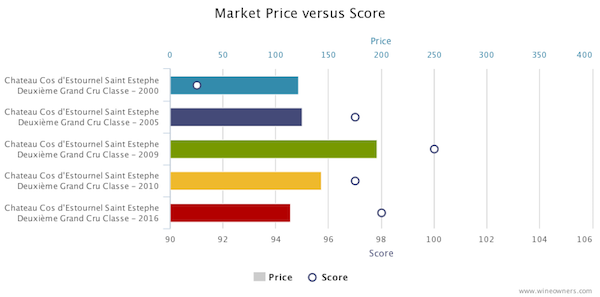
by Wine Owners
Posted on 2016-05-09
As we jump into the 2015 En Primeur campaign with analysis and our recommendations of those wines that could be worth buying early on, let’s have a look at how last year’s 2014 En Primeur ‘picks’ have performed.
We used our price per points analysis to identify relative value of the 2014 releases vs comparable back vintages vintages
It's worth noting that wines that we felt could have been worth buying early were a little more than a handful, out of the swathe of en primeur releases. But then, there are only about 60 wines potentially worth bothering with these days. Buying the equivalent of cru bourgeois releases as a future is surely a mug's game these days. Of the 60 or so top producers who released in 2014, we thought there were about 8 wines worth buying as a future.
Here's how they performed...
Chateau Lafite Rothschild 2014
Last year you could have bought a 12x75cl case of Château Lafite Rothschild 2014 for £ 2,700. Since then, it's increased to £3,300 (12x75cl) which represents a growth of 18% from it’s initial released price.
It was a tough one to taste at the property in April 2015, but we took a punt on it as proper wine - at least there was no lipstick applied to the barrel samples.
Chateau Calon Ségur 2014
Released at £410-£420 (12x75cl) retail, Calon has increased in price by 23.2% and stands at a market price of £505. It's worth noting volume of wine released En Primeur was much reduced last year and négociant channels were heavily rationalised. Having been earlier acquired by new owners for €200M, expect further 'management' of En Primeur releases in an attempt to drive the secondary market price.
Chateau Margaux 2014
The release price of Chateau Margaux 2014 was £ 2,340 (12x75cl).
Market price has risen to £ 2,850 for a case of 12 in one year, and increase of 21,8%.
Robert Parker Score : 93-95
Petit Mouton 2014
Le Petit Mouton’s release price was £ 750 per case of 12 bottles, the closest thing to a ‘one way bet’ we found last year, and I filled my personal boots. Given how well this atypically predominant cabernet Sauvignon Petit Mouton has performed in the last 12 months, we hope you did too! It was also the most delicious and impressive wine, and felt to me a little under-rated by Neal.
The price of Le Petit Mouton has increased by 30% going from £ 750 to £ 1,080 for 12x75cl.
Robert Parker Score : 90-92
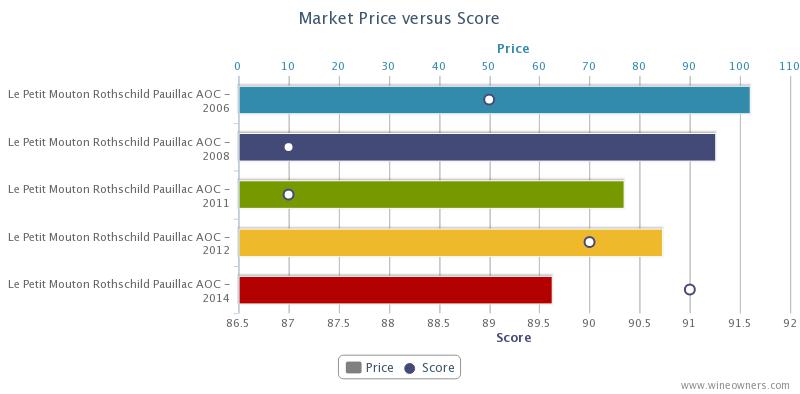
Chateau Mouton Rothschild 2014
Along with Petit Mouton, we loved Mouton last year, with its merlot so successful on gravel that a large slug of it made it into the Grand Vin. The trade was baying for release prices close to 2008 (£1750-£1800), but we thought £2,300 was a fair price for the quality, especially in the light of how much market momentum there has been behind Mouton of late.
Mouton 2014 has increased from it’s release price to £ 2,700, an increase of 13%.
Robert Parker Score : 96/100
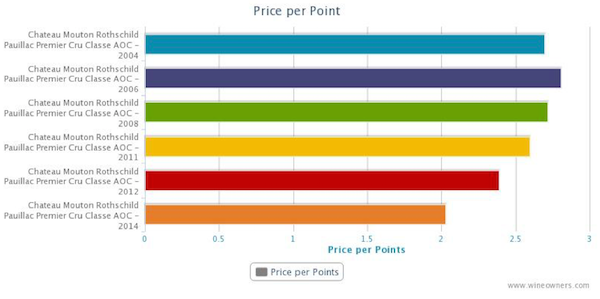
Chateau Lynch-Bages 2014
Chateau Lynch-Bages 2014 was universally declared good value by the wine trade last year, and released at £580.
Over the past year it rose from £ 580 to £ 650 (12x75cl) representing an increase of 12%.
Robert Parker Score : 92 -94

Chateau Canon 2014
This stood out as proper wine last year as well, and tasted alongside some heavyweights held it's own. Re-tasted this year, it's shutting down and wasn't the most exciting wine on earth. The price hasn't budged either way from its release price of £375. One that in retrospect we should not have recommended to buy early.
by Wine Owners
Posted on 2016-04-07
When asked by a French journalist if he thought 2015 was an antidote to the Bordeaux fine wine market 'bashing' of certain journalists, Monsieur Rolland let fly:
“There’s no cure for imbecility - it's reaching colossal proportions. For me, 2015 is a truly great vintage. There are too many idiots to notice. They’ll figure it out in 10 years’ time, as usual. We live in a world without gumption; with people without balls. End of story. There isn’t a journalist who's seeing it. Anyway, there isn’t a wine writer with any substance in the world today. I don't give a damn about what journalists say. That has nothing to do with the market. They can say, write and think what they want; the world won't give a hoot, just as it doesn't care what happened in 40 AD! (from the idiom 's'en foutre comme de l'an quarante' - a year which had been predicted as the end of the world). When they realise that, maybe they’ll eat humble pie. Not that they’ll become intelligent - that will be difficult - but maybe they'll learn to think differently.”
by Wine Owners
Posted on 2015-06-10
Jane Anson’s insight into what courtiers and négoces think about the en primeur system makes for very interesting reading.
Perhaps what many Chateaux are unwilling to go on record with is the question of estate value.
Land values are at least partially driven by the cost per bottle that can be achieved by the Chateaux at the point of release. The higher the release price (whenever that is) the higher the cost of land per hectare.
If you've just blown €200M on a slice of prime classed growth real estate, you want to support the underlying assumptions upon which that price was predicated. The balance sheet value of that asset and its ability to appreciate over time (and not see shareholder value diminished) becomes pretty crucial.
Is this one of the reasons why Calon released so little and massively cut back on the number of Négoces they allowed allocations, narrowing channels to market?
We totally agree with Jane Anson that a number of the First Growths got their pricing right. For me Lafite at first tranche and Mouton (Grand and Petit) got it most right vs market pricing of back vintages. There is future value in those purchases.
The sooner the 'funding' model of EP is clarified, the sooner the negativity surrounding the EP release period will evaporate. I think consumers dislike conflicting messaging and behaviour as much as channels of distribution do.
Let's say it; the top Chateaux (the only part of the EP market that appears to be worth bothering with) don't need us to fund the next vintage. Nor therefore do they have a need to leave enough on the table to convince us of the opportunity-cost of stockholding for them. That illusion is about to be shattered.
by Wine Owners
Posted on 2015-03-16
With Robert Parker handing over the reins of Bordeaux Primeurs tasting to Neal Martin, what are the implications?
The first, most obvious, change is Neal’s palate.
However objective a critic may be, his or her palate and personal preferences inevitably play a big part. Where Parker excelled was at getting his impressions across in a particularly accessible and descriptive way; not easy when tasting barrel samples. The temptation is to describe a wine in its elemental state elementally, which isn't that interesting to read. He described its future, and over the years demonstrated he was rather good at that.
His personal preferences may have veered towards a sunnier style of wine, but he tended to let the wine buyer know if a wine was stylistically towards one end of the spectrum or another. But it must be very hard to award a great score to a wine that doesn’t move you viscerally, and to that extent personal preferences must come into play.
Martin’s tasting preferences are naturally more European than Parker’s, and is perhaps more likely to be dazzled by finesse and complexity over power, texture and rich fruit. This is a gross oversimplification for sure, but perhaps suffice to say his evaluations will be his own.
The second is winemaking trends.
The trend back towards a more classical form of winemaking is already underway (allied to far better vineyard husbandry than was broadly the case when Parker started out – he is often attributed with raising standards). Use of new oak is being moderated at many Chateaux, and régisseurs are looking at ways to fully express and nuance their amazing terroirs, sub-plots and micro-climates whilst making the most of Bordeaux’s inherent ability to bear and bottle the most age-worthy wines in the world.
The tendency of the late 1980s and 1990s towards making and showing the kind of wines proprietors thought would garner the best scores early on is on the wane. If the world’s leading critics and evaluators of young Bordeaux favour a finer-boned vernacular, this will be reflected in the market, which is more likely than not to reward those styles of wine with the greatest demand.
The third change is context.
Back in the early 1980s there was no Internet, market transparency was therefore limited and the market was much narrower than today’s. Can another critic, however good, assume the same degree of importance and purchasing influence over a market in the way that Parker has achieved? If so, will they come from Europe or do they have to be American? Or Asian?
Will crowdsourcing views and reviews become a proxy for the next leading critic of his or her generation, a perspective that arises with the growing importance of the Internet? I wonder. Some may argue that buyers are too ready in our online age to trust the word of a virtual room-full of complete strangers over the words of an advisor or friend. Whilst such principles may work well for holiday destinations or white goods manufacturers, it’s tougher to see how this will ultimately prevail for the finest of fine wine. How experienced is the taster, do they have a bank of reference points in respect of tasting young wines, and can they draw parallels between what a wine tasted like when in barrel compared with 10-15 years on? Can they recognise the future evolution of a young wine, see similarities and differences, then context (and visualise) the next young wine they taste accordingly? What does it mean when experienced tasters say that great wine is born great? What does great taste like? What’s the palate preference of each taster; where on the spectrum do they sit?
That’s an awful lot of questions to ask of a crowd, especially when most of them have day jobs. Broadly, people may not care about all that of course; but people into their fine wine, and making spending decisions based on the judgement of others, will care. That’s why evaluators of fine wine such as Neal Martin, Jancis Robinson, Stephen Tanzer, Antonio Galloni, Tim Atkin, Will Lyons, and many other talented writers (see here) matter so much.
What could be somewhat significant in turning reputation and influence into market impact is the business model deployed. What I wonder is this: with the Internet capable of coalescing huge audiences and showing the true - often massively underestimated - size of market niches, will blanket subscription firewalls allow wine writers to maximise market influence?
How experts in general monetise their high value content may yet change over the next few years, perhaps in a parallel way that the music business experienced a profound shift from selling records to selling bums on seats and festival tickets. Will the experiential become the bigger money-spinner? How the world’s critics engage with their audience and allow them an element of participation and dialogue may prove decisive for the next Parker, if there is to be one. Being social web savvy can only but help.
The fourth change may be the end to ‘wait and see’.
If the Chateaux knew Robert Parker was coming to Bordeaux, they might hold off from releasing until his scores were known, and the job of negociant and merchant alike was simplified, if sometimes a little delayed.
When Parker didn't come to town within a few months of the new vintage, the market reflected the collective views of the wine industry that had tasted samples most frequently (producers, courtiers, negociants, importers) and added a dose of realism to do with the macro-economic context. Price differentials within a set of wines (e.g. First Growths) were narrower. So, famously, 1990 was priced cheaply in the recession of 1991 as was 2008 in the post-Lehmann, financially sclerotic environment of 2009.
In the short term at least, all the leading critics will turn up to taste on time and publish on time. The extent to which they will collectively or individually influence prices (and demand) remains to be seen, but it would be more surprising if they didn’t have at least some bearing on the market. Producers are more likely to have made up their mind on pricing based on their qualitative assessments early on, and perhaps we shall all be spared interminably long campaigns.
